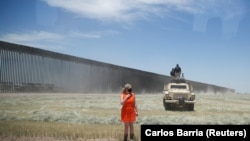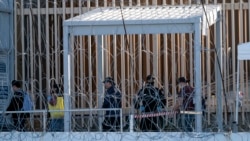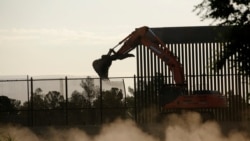The night of October 29, the U.S. Department of Homeland Security’s spokesman, Chase Jennings, posted a Twitter thread about the U.S.-Mexico border wall.
"Since we've reinvested in border security under this administration, the results speak for themselves: Illegal drug, border crossings, and human smuggling activities have decreased in areas where barriers are deployed,” he wrote.
The thread included a couple statistics about declining border crossings between the 2019 and 2020 federal fiscal years (FY), which end in September. “Illegal entries in areas of Yuma [Arizona] sector with new border wall system plummeted over 87% in FY 20 compared to FY 19,” Jennings wrote. He also cited a 79 percent decline in the Rio Grande sector.
While border apprehensions are down, attributing the drop to the wall is misleading. The declines reflect a broad trend driven in part by the coronavirus pandemic and the effects of other Trump administration policies to discourage asylum seekers and make it easier to deport them.
The Department of Homeland Security (DHS) and Office of Customs and Border Protection (CBP) did not respond to Polygraph.info’s requests for comment on this fact-check.
Pandemic pressures
Amid the coronavirus pandemic, President Donald Trump declared that “border security is also health security,” and his administration over the past year has rushed to meet his goal of constructing 450 new miles of border wall in his term of office.
According to news reports, construction crews had been adding close to two miles per day – and bringing dozens of lawsuits against landowners in places like south Texas and cutting through national forests, wildlife preserves and other public lands under federal control.
Between Trump’s inauguration in January 2017 and April 22, 2020, 170 miles of border wall were built by the administration. In the seven months that followed, 230 extra miles were built. The DHS, which includes the Customs and Border Protection office, celebrated the 400th mile of border wall on October 29.
Authorities at CBP track the number of apprehensions of migrants who ask for asylum or try to avoid detection at the border or if encountered after crossing. Overall, the total count of southwest border encounters dropped 53 percent in recently ended fiscal 2020 to 400,651.
According to the CBP data, the biggest decline in encounters/apprehensions happened this past March and April, when the U.S. entered a state of emergency for the coronavirus pandemic, allowing the president to take stricter border enforcement measures. By September, total monthly encounters had once again ticked up to their highest number this year.
“Of course, when you compare numbers from 2019 and 2020, you have to take into account the pandemic, where we saw greatly reduced numbers of people trying to cross. Particularly in the beginning, particularly with families,” Jessica Bolter, an associate policy analyst at the Migration Policy Institute, told Polygraph.info.
The Yuma sector followed a similar pattern. CBP data show border apprehensions fell in April then rose in May through September. Apprehensions of "unaccompanied alien children” in the Yuma area decreased 91 percent in fiscal 2020 from the prior year. “Family units” encounters decreased 94 percent and encounters of single adults were down 43 percent, CBP data show.
Although those are big drops, they are roughly in line with some of CBP’s other sectors. For example, family encounters dropped 94 percent in the Rio Grande sector, 87 percent in Big Bend and El Centro, and 92 percent in El Paso, the data show. In all those areas, the border wall remains a work in progress.
El Paso, CBP data shows, has approximately 24 miles of “new border wall system” completed, 41 miles under pre-construction and 92 miles under construction. Rio Grande Valley has three miles of completed wall, 93 miles under construction and 14 miles under pre-construction. El Centro has 17 miles of completed wall, 14 miles under construction and 13 miles under pre-construction (12 of which are secondary walls).
At the same time, encounters/apprehensions also went up in some of the sectors where the wall is supposed to be a deterrent. In El Paso, for example, single adult encounters went up by 18 percent in the fiscal year. The Laredo sector, with 121 miles of border in pre-construction, saw a 35 percent increase in single adult encounters, a 62 percent rise in family unit encounters and a 5 percent increase in unaccompanied children.
‘Remain in Mexico’
Rules established in March allowed the CBP to keep out anyone potentially presenting a COVID-19 risk at the border. But even before the pandemic, more restrictive Trump administration policies were put in place that help explain the decline in encounters.
In the summer of 2019, Mexico agreed under the administration’s “Remain in Mexico” policy (also known as Migrant Protection Protocols, or MPP) to take back migrants picked up at all border locations rather than just a few, Bolter said.
Under the policy, asylum seekers at ports of entry would wait for their U.S. immigration proceedings in Mexico instead of the United States. Mexico also stepped up its own immigration enforcement, making it harder for immigrants to cross through and reach the U.S.
During the 2020 presidential race, then-candidate Joe Biden promised to end the MPP policy. Since his projected victory over Trump in the November 3 election, immigrants stuck on the Mexican side of the border have expressed hope that Biden will follow through, BuzzFeed News reported. The Biden transition team did not respond to Polygraph.info’s request for comment.
In 2019, the U.S. also signed Asylum Cooperative Agreements (“ACAs”) with the Northern Triangle countries of El Salvador, Guatemala and Honduras. These agreements allowed the U.S. to deport asylum seekers to one of the three countries so long as they have “access to a full and fair procedure for the determination of their [asylum] claim” and aren’t at risk of their lives. (Critics say the agreements are illegal and fail to provide a safe haven for asylum seekers.)
Based on the numbers, all these policies likely have had a deterrent effect. Total single adults apprehended at the Mexican border ticked up only 5 percent in 2020 to 317,864. Family encounters plunged a whopping 89 percent overall to only 52,230 from nearly half a million the prior year.
Bolter attributes the latter drop mainly to the coronavirus and fear of contracting the virus while traveling. “Families are much less likely to subject their children to that,” she said.
The Wall
Trump’s signature campaign promise in 2016 was to “build a wall” along the 2,000 miles of the southwest border. Before he took office, 654 miles already had barriers – 354 miles to stop pedestrians and 300 miles of vehicle fencing. As Polygraph.info reported in July, most of the border-wall construction under the Trump administration has replaced already existing barriers.
On October 31, the BBC reported that 669 miles of the southern border had “primary barrier” and 65 miles of “secondary barrier” – built behind a primary structure. Only 15 miles of new, primary barriers had been built, the BBC said, citing a Trump administration report.
The BBC said 350 miles of replacement or secondary structures were finished, while 378 miles of new and replacement barriers are “either under construction or in the 'pre-construction phase’." Less than half of this will be in locations where no barriers exist now, according to CBP.
Advocates for the wall and administration officials, such as the CBP Commissioner Mark Morgan, argue that the old barriers weren’t proper walls and needed to be strengthened.








